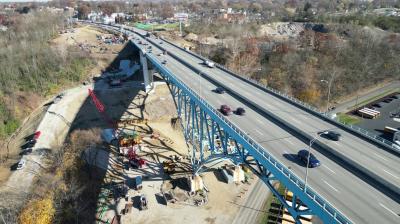Tampa Bay Water, a government agency that provides wholesale water to Hillsborough, Pasco and Pinellas counties in Florida, recently was challenged to find alternatives for groundwater pumping. Its solution: a massive $86 million, 15 billion gallon above-ground reservoir that will increase the area’s water supply by an average of 24 million gallons per day.
The entire project, which took 10 years to plan, is a massive technological and structural challenge, boasting a sophisticated 100-mi. (160.9 km) plus piping system.
At the Construction Site
Barnard Construction, the prime company, mobilized in June 2002 and began clearing ground the following September.
Derek Tisdel, project manager of Barnard, said he has a crew of more than 100 employees on site constructing an 84-in. (213.4 cm) transmission main. The crew also is completing site civil work and dewatering.
The above-ground reservoir is being made out of dirt and an impervious layer of 16 mill geo-membrane liner created out of HDPE plastic.
“A crew of about 100 excavated and plied the former farmland,” said Tisdel.
Barnard is placing the soil cement with Cat 740 ejector trucks and dozers. The embankment construction for the reservoir is ongoing.
Subcontractor McDonald Construction, based in Lakeland, FL, is moving all the earth on the reservoir embankment. The company is using a variety of equipment, including D8 and D9 Cat dozers, 40-ton (36.3 t) haul trucks, Cat 731 scrapers and a variety of compaction equipment.
The cement and soil mix is dumped into those trucks then poured down the sides of the structure and smoothed over.
“They have different road blades out here; 412s and 416 Caterpillars. We use mostly Caterpillar equipment,” said Tisdel.
Barnard has had to overcome a number of challenges at the job site, but the most daunting has been the wet weather.
“In anticipation of the possibility that this will be a wet summer, our plan is to get the majority of earthwork and other processes affected by rain completed before June. That will minimize delay, leaving us road construction and asphalt, with only the minor finishes to complete,” said Tisdel.
On site, a computerized cement-mixing plant helps ensure adherence to the construction schedule, and an on-site soil laboratory tests the varying porous soils before they’re used on the project.
How It All Works
The Tampa Bypass Canal pipeline carries water from its pumping station to the regional surface water treatment plant.
According to a Tampa Bay Water report, the South-Central Hillsborough Intertie, or pipeline, will convey water from the Alafia River pumping station to the new regional surface water treatment plant. Once the regional reservoir is constructed, it will carry surplus water from the Alafia and Hillsborough rivers and the Tampa Bypass Canal to the reservoir for storage.
During dry times, this bi-directional pipeline will carry water from the reservoir to the regional water treatment plant.
In rainy periods, rivers run high. During those times, according to the agency, “the pumping stations follow a permitted withdrawal schedule to skim water from the Alafia and Hillsborough rivers and the Tampa Bypass Canal.”
The first 66 million gallons per day from the surface water sources will be processed at the regional surface water treatment plant for immediate distribution to Tampa Bay Water members. Any remaining permitted quantity could be sent to the regional reservoir for storage.
According to the report: “During the dry season, when river flows are low, little or no water will be pumped at the Tampa Bypass Canal and the Alafia River pump station. At that time, water stored in the reservoir will be withdrawn to supply the water treatment plant.
“By collecting and storing water during high flow periods, we can meet the region’s need for water year round without harming the environment, even during dry conditions.”
Water can be stored in the reservoir indefinitely.
Putting It Together
Government agencies required that significant environmental restoration and mitigation be done. Permits were required from the U.S. Army Corps of Engineers, Southwest Florida Water Management District and others.
Researchers evaluated the cumulative effects of withdrawals from the Master Water Plan sources on Tampa Bay at the University of South Florida College of Marine Science in St. Petersburg. This, as well as a number of other studies, determined that the environment was not at risk. In fact, Tampa Bay Water will implement a comprehensive hydro-biological monitoring program designed to identify any adverse effects associated with surface water withdrawals, should they occur, and what steps will be quickly taken if so identified.
Mandi Rice, project manager of Tampa Bay Water, is excited about the positive alternative this construction will bring.
“This reservoir will allow us to use surface water sources in an environmentally and economically sound manner,” said Rice. “This will enable the community to have a consistent supply throughout the dramatic Florida weather changes that meets or exceeds all EPA required safe drinking water standards.”
Rice noted that to run a surface water treatment plant consistently, not intermittently, a reservoir is needed.
“People typically think of such a place as being an end-stream facility that would have a large impact to the river system and adjacent residents. As an off-stream, above ground facility, this type of reservoir is fairly new.”
Once full to capacity, the surface water will have an area of 930 acres (376.4 ha). The actual facility, all the way out to the “toe” including its perimeter road, will be approximately 1,100 acres (445.2 ha).
At first, local residents had some reservations about such a project going up in their neighborhood. However, Rice explained, they’ve come to understand how this building will have intrinsic values.
“This piece of property that was purchased, along with all the wetland mitigation, covers 5,230 acres. It’s in a very rural part of the county,” she said. “The site is surrounded on three sides by water tributaries. On one side there are homes. The people who live out there made a clear choice, and this will ensure for them that in an area that hosts this large amount of acreage, it will be permanently preserved and won’t contribute new developments, traffic and so forth.”
Rice said that a landscape berm already was planted to add to the aesthetics and subdue construction noise. Cattle pastures are being renewed into vibrant uplands and living wetlands. Wading birds are returning to the re-established marshes.
“We’re expecting that our neighbors will see this construction as a positive part of their surroundings,” she said.
Tisdel also noted that the problem poses little danger to the surrounding area.
“Risk of catastrophic failure is slim-to-none,” he said. “Any type of failure that might be experienced, such as a leak or heavy erosion in a particular area with a possible breach, would become known immediately. Administrators would have the ability to drain the reservoirs through its pipeline and get rid of the water in a controlled fashion. Solutions could be implemented at once. Serious problems should never be of concern.”
The Southwest Florida Water Management District purchased the 5,230 acres (2,116.5 ha) needed to build the reservoir for $26 million. The Environmental Protection Agency provided $46 million in federal grants. In addition, Rice is seeking $10 million or more in grants.
The price tag on the entire project runs about $170 million. Taxpayers will pay slightly higher fees to Tampa Bay Water. Those fees will increase about 25 cents per day over the next 10 years.
Today's top stories















